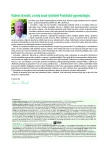New laboratory diagnostic techniques and prediction of preeclampsia
Authors:
Olga Bálková
Authors‘ workplace:
Roche s. r. o., Diagnostics Division, Praha
Published in:
Prakt Gyn 2014; 18(2): 127-129
Category:
Gynecology and Obstetrics: Review Article
Overview
Detection of preeclampsia is still challenging for gynecologists and obstetricians. Clinicians consider only non-specific complaints and clinical signs in diagnosis process. An important aid offers ultrasound examination of fetus and uterine arteries. Up to now we can evaluate pathological findings from laboratory tests such as liver function tests, renal examination parameters, uric acid, blood coagulation or platelet count only in developed preeclampsia or in onset of eclampsia. Logically, researchers were challenged to find objective laboratory parameters with higher sensitivity and specificity useful in diagnosis of preeclampsia and ideally also in its prediction.
Key words:
angiogenic dysbalance – eclampsia – preeclampsia – placentar growth factor – plGF – fms-like tyrosine kinase-1 – sFlt-1
Sources
1. Levine RJ et al. Circulating Angiogenic Factors and the Risk of Preeclampsia. N Engl J Med 2004; 350(7): 672–683.
2. Rana S et al. Angiogenic Factors and the Risk of Adverse Outcomes in Women With Suspected Preeclampsia. Circulation 2012; 125(7): 911–919.
3. Thadhani R. Preeclampsia Early Adopters Meeting. Ústní sdělení, Linz (Austria), duben 2013.
4. Schnettler WT, Dukhovny D, Wenger J, Salahuddin S, Ralston SJ, Rana S: Cost and resource implications with serum angiogenic factor estimation in the triage of pre-eclampsia. BJOG 2013; 120(10): 1224–1232.
Labels
Paediatric gynaecology Gynaecology and obstetrics Reproduction medicineArticle was published in
Practical Gynecology

2014 Issue 2
Most read in this issue
- Atypical findings in the diagnostics of precancer and cancer of cervix: case reports
- Advantageous properties of gestodene and its use in combined hormonal contraception
- Jsou vaginálně aplikované izoflavony vhodnou náhradou estrogenů?
- Smoking cessation in pregnancy
